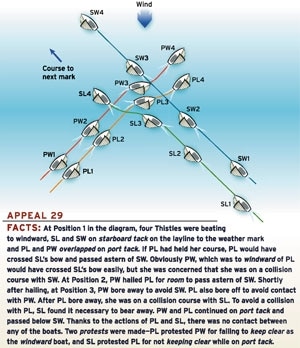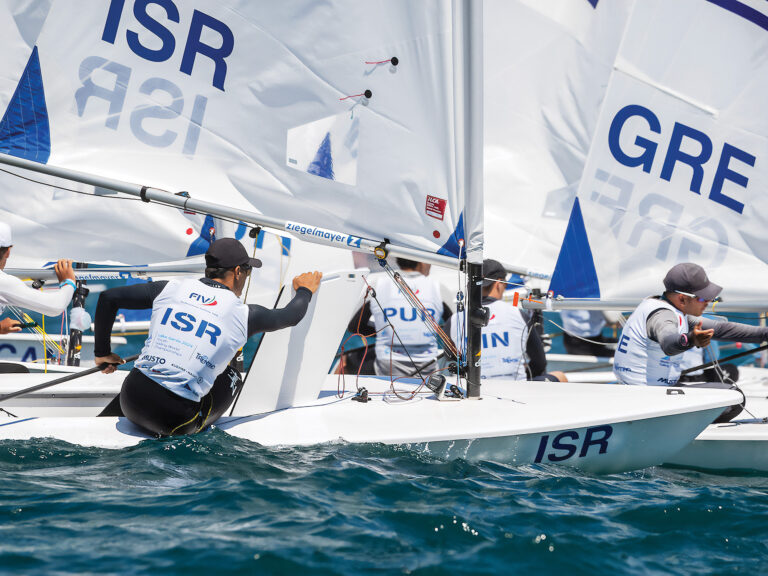
The new appeals book, US SAILING Appeals for 2001-2004, is now available. If you purchase the U.S. appeals you also get, at no additional cost, the ISAF Case Book for 2001-2004. The appeals and cases are important resources to consult whenever you’re preparing for a protest hearing. They’re also a great teaching tool. There’s no better way to improve your knowledge of the racing rules than to work your way through these two companion volumes, treating each appeal (or case) like a quiz. Most appeals include a complete description of an incident (the Facts) followed by an interpretation of the relevant rules (the Decision). A few are presented in Question-and-Answer format. Each one begins with list of the rules that the appeal interprets.
I recommend you use each appeal as a mini quiz. First, read all the rules that are interpreted so that you have them firmly in mind. Then study the Facts, and, without looking at the Decision, work out what you think the Decision should be. Finally, check your reasoning against the appeals committees. By way of example, the Facts for Appeal 29, a particularly interesting appeal, are presented at right; the Decision is in a second box on the next page. (I have expanded on US SAILINGs discussion to drive home the appeals lessons.)
There are useful sections in the appeals and case books to help you organize your quizzes around individual rules or concepts. If you would like to study all the appeals that interpret a particular rule or definition, you can quickly find them by looking in the Abstracts section at the beginning of each book. The Appeals books also contain an index of key words and phrases in the US SAILING appeals. There you can find a list of all the appeals that cover important terms that are not defined in the Definitions section of the rulebook. For example, there youll find lists of the appeals that mention terms such as protest flags, hails, redress, starting lines, and collisions.
You’ll find other uses for the appeals and cases. Whenever those of us on the ISAF Racing Rules Committee change a rule, we almost always try to write a simpler, clearer, more understandable rule that leaves the game we play essentially unchanged. The new appeals book gives us a chance to evaluate how were doing.
One measure of how well we have succeeded at leaving the game unchanged is the number of times a different boat must be penalized in an old appeal as a result of the changes in a new rulebook. There are 65 appeals that appear in both the 1997-2000 and the 2001-2004 appeals book. Not one of the Decisions in those 65 appeals was changed as a result of the changes made in the 2001-2004 rulebook, which seems remarkable given that the frequently invoked mark-rounding rule (Rule 18) was substantially revised in 2001.
Another measure of how well were doing is the number of appeals published during the four-year rulebook cycle. There were 23 published U.S. appeals between 1993 and 1996, the last four-year cycle during which we used the old International Yacht Racing Rules. Since 1997 the simpler and shorter Racing Rules of Sailing have been in use. Between 1997 and 2001 there were only seven published U.S. appeals. That suggests that, just maybe, the new rules really are simpler and easier to understand.
The appeals book is also very useful as a source of ideas for improving the rules. One statistic is striking. There are a total of 181 appeals and cases in new US SAILING publications, and 30 percent of them interpret one of the rules in Part 5–the rules that cover protests, redress, hearings, misconduct, and appeals. No boat ever protests another boat under one of those rules. Therefore, the fact that those rules are so often interpreted suggests that an effort to rewrite them more simply and clearly might be worthwhile.
You can access the ISAF Case Book on the Internet for free at two different web sites. Its available as an Adobe PDF file at www.sailing.org/rrs2001 (scroll to the bottom of page). It is also available at www.isafrules.com (a site that is not managed or produced by ISAF). That site was produced in Korea by Heebum Kwon. There you will find hypertext links to all the interpreted rules and animated diagrams. You will need a program called Flash Player. If your browser doesnt include this program, you can download it free at www.macromedia.com.
There are two other ISAF publications in which the rules are interpreted–the Call Book for Match Racing for 2001-2004 and the brand new Call Book for Team Racing for 2001-2004. Both are available at no charge as Adobe PDF files at www.sailing.org/rrs2001 (scroll to the bottom of the page). These calls are authoritative ISAF interpretations only for umpired match racing and team racing.
In my April Rules column, which addressed what your options are after you lose a protest, I should have said that, if you wish to appeal a decision of a protest committee, you have 15 days from the date you receive the protest committees written decision to send your dated appeal along with the written decision to the appropriate appeals committee (see Rule F2.1).
E-mail for Dick Rose may be sent to rules@sailingworld.com.









